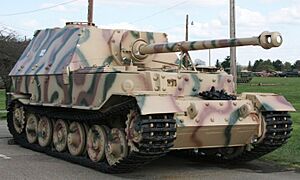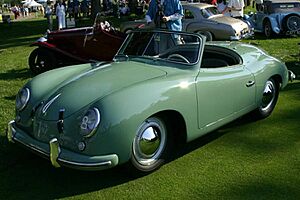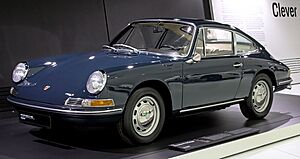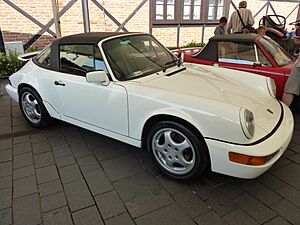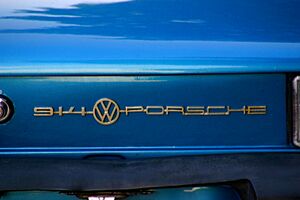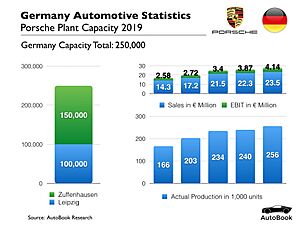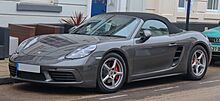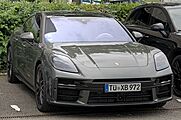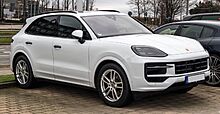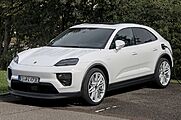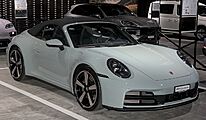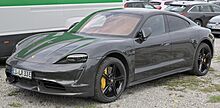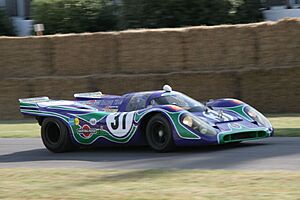Porsche facts for kids
 |
|

Headquarters in Stuttgart, Germany
|
|
| Public (Aktiengesellschaft) | |
| Traded as | FWB: P911 DAX component |
| ISIN | [https://isin.toolforge.org/?language=en&isin=DE000PAG9113 DE000PAG9113] |
| Industry | Automotive |
| Founded | 1931 in Stuttgart, Germany |
| Founder | Ferdinand Porsche |
| Headquarters | Stuttgart, Germany |
|
Area served
|
Worldwide |
|
Key people
|
|
| Products | Automobiles |
|
Production output
|
|
| Services | Automotive financial services, engineering services, investment management |
| Revenue | |
|
Operating income
|
|
| Total assets | |
| Total equity | |
| Owners |
|
|
Number of employees
|
42,615 (2024) |
| Subsidiaries |
|
Porsche (pronounced POR-shə) is a German company famous for making high-performance sports cars, SUVs, and sedans. Its main office is in Stuttgart, Germany. The company is owned by the Volkswagen Group, which also owns brands like Audi and Lamborghini.
Porsche is well-known for cars like the 911, 718 Boxster/Cayman, Panamera, Macan, Cayenne, and the electric Taycan.
The company was started in the 1930s by an engineer named Ferdinand Porsche. One of his first major projects was designing a car for the German government that later became the famous Volkswagen Beetle. After World War II, his son, Ferry Porsche, started building the company's own sports cars, beginning with the Porsche 356.
Contents
History
How Porsche Began
Ferdinand Porsche (1875–1951) started his company in Stuttgart in 1931. At first, the company didn't build its own cars. Instead, it worked on car designs and ideas for other companies. One of its first big jobs was to design a "people's car" for the German government. This car was the Volkswagen Beetle, which became one of the most popular cars ever made. Using parts from the Beetle, Porsche later developed its own car, the Porsche 64, in 1939.
During World War II, the company's work shifted to military vehicles. Porsche designed powerful heavy tanks, but other companies were chosen to build them. However, the design for one of Porsche's tanks was used to create a tank destroyer called the Elefant. During the war, many people were forced to work in the factories.
After the war ended in 1945, Ferdinand Porsche was arrested because of his work during the war. While he was away, his son, Ferry Porsche, took charge. Ferry wanted a special sports car but couldn't find one he liked, so he decided to build his own. This led to the creation of the 356, which is considered the first true Porsche car because it was the first model the company sold.
The first 356s were built in a small workshop in Austria. When enough people ordered the car, production moved to Stuttgart, Germany. The car's body was made of steel, and it was officially approved for road use in 1948.
The Porsche Logo
The Porsche company logo is a mix of two historic designs. It includes the coat of arms of the former German state of Württemberg, where Stuttgart is located. In the center of the logo is the coat of arms of the city of Stuttgart, which features a black horse.
The combination of these symbols with the words "Porsche" and "Stuttgart" creates the famous badge seen on every Porsche car today.
Famous Porsche Models
After the war, car parts were hard to find. The first Porsche 356 models used many parts from the Volkswagen Beetle, including parts of its engine and suspension. Over time, Porsche began making its own parts, and the 356 became more unique. The car was known for its sleek, rounded body and its rear-engine design, which gave it excellent balance.
In 1964, Porsche introduced its most famous car: the Porsche 911. Like the 356, the 911 had an air-cooled engine in the back. This time, it was a more powerful six-cylinder "boxer" engine. The design was led by Ferry Porsche's son, Ferdinand Alexander Porsche. The 911 quickly became a huge success, both as a road car and as a race car. Today, the 911 is still in production and remains Porsche's most iconic model.
Becoming a Modern Company
In 1972, Porsche changed from a family-run business to a public company. This meant that people outside the Porsche family could help run the company. Ferry Porsche's nephew, Ferdinand Piëch, who was a brilliant engineer for Porsche, went on to lead the entire Volkswagen Group.
In the 1990s, Porsche worked with Toyota to learn about more efficient ways to build cars. This helped Porsche become a very profitable company. The introduction of the Cayenne SUV in 2002 was a huge success and helped the company grow even more. A new factory was opened in Leipzig, Germany, to build the Cayenne.
In 2011, Porsche Cars North America moved its headquarters to a new location in Atlanta, Georgia, which includes an office building and a test track.
Relationship with Volkswagen
Porsche and Volkswagen have always had a close connection. The first Volkswagen Beetle was designed by Ferdinand Porsche. Over the years, the two companies have worked together on several cars.
- The 914 (1969): A sports car sold as a VW-Porsche. Some versions had a Volkswagen engine, while others had a Porsche engine.
- The 924 (1976): This car used many parts from Audi, which is part of the Volkswagen Group.
- The Cayenne (2002): This popular SUV shares its main frame with the Volkswagen Touareg and the Audi Q7.
In 2011, Porsche and Volkswagen officially merged their car-making businesses. Today, Porsche SE (the holding company) is the main owner of the Volkswagen Group, and Porsche AG (the car company) is one of the many brands within the group, alongside Audi, Bentley, and Lamborghini.
Production and Sales
Porsche's main factory is in Zuffenhausen, a district of Stuttgart. This is where the famous 911 sports car and all Porsche engines are made. The Panamera and Macan models are built at the factory in Leipzig, Germany.
Porsche is known for being one of the most profitable car companies in the world. It sells cars all over the globe, with major markets in North America, Europe, and China. In 2017, the one-millionth Porsche 911 was built. It was painted in a special Irish green color and sent on a world tour before being placed in the Porsche Museum in Stuttgart.
| Year | Production | Sales |
|---|---|---|
| 2006 | 102,602 | 96,794 |
| 2010 | 89,123 | 81,850 |
| 2015 | 234,497 | 225,121 |
| 2020 | 263,236 | 272,162 |
| 2022 | 321,321 | 309,884 |
What Cars Does Porsche Make?
Porsche produces a range of different models. In 2022, the company built over 320,000 vehicles. The most-produced models were the Macan and Cayenne SUVs, followed by the classic 911.
The company is also moving toward electric vehicles. In 2021, Porsche confirmed it would open its first production plant outside of Europe in Malaysia.
Current Porsche Models
Note: Models in bold are currently in production.
Electric and Hybrid Cars
Porsche is a leader in creating high-performance electric and hybrid vehicles.
- Cayenne S E-Hybrid: A plug-in hybrid version of the popular SUV.
- Panamera S E-Hybrid: A plug-in hybrid version of the four-door sedan.
- Taycan: Porsche's first all-electric car, introduced in 2019. It is known for its incredible speed and fast-charging technology.
Porsche has installed some of the world's fastest electric vehicle charging stations. These stations can charge a Taycan's battery to 80% in just 15 minutes.
Porsche in Racing
Porsche has a legendary history in motorsport. The company is the world's largest maker of race cars and has won the famous 24 Hours of Le Mans race a record 19 times.
From the classic 911 to the high-tech 919 Hybrid, Porsche's race cars have competed and won in nearly every type of racing around the world. This success on the track has helped build Porsche's reputation for performance and reliability.
Images for kids
See also
 In Spanish: Porsche para niños
In Spanish: Porsche para niños


